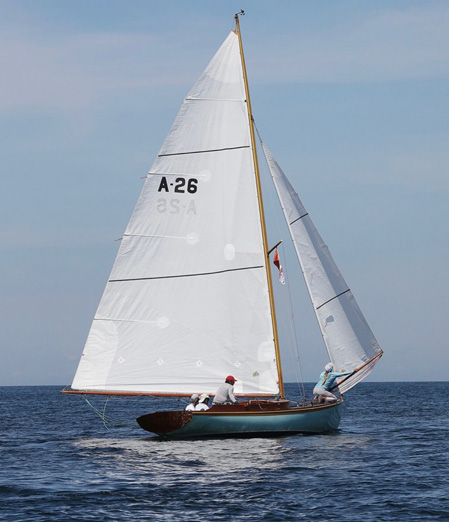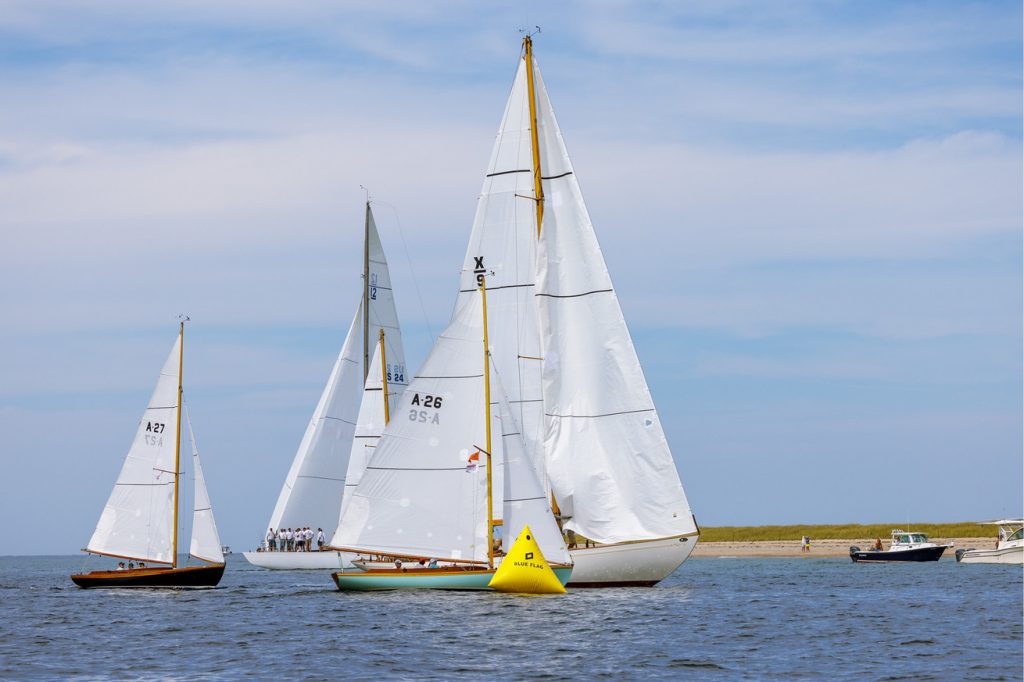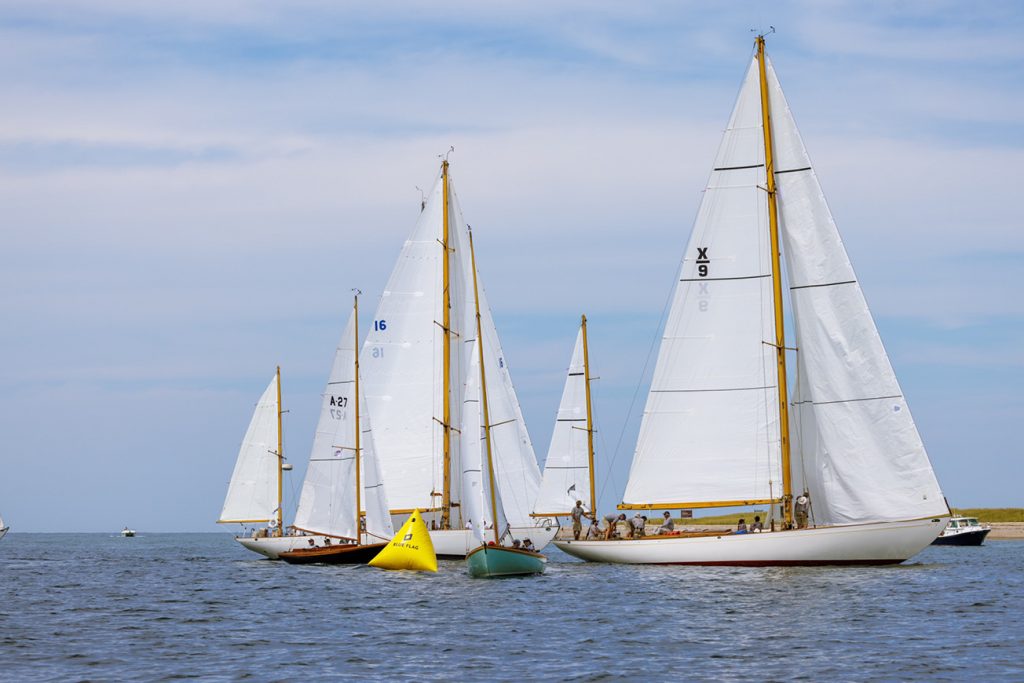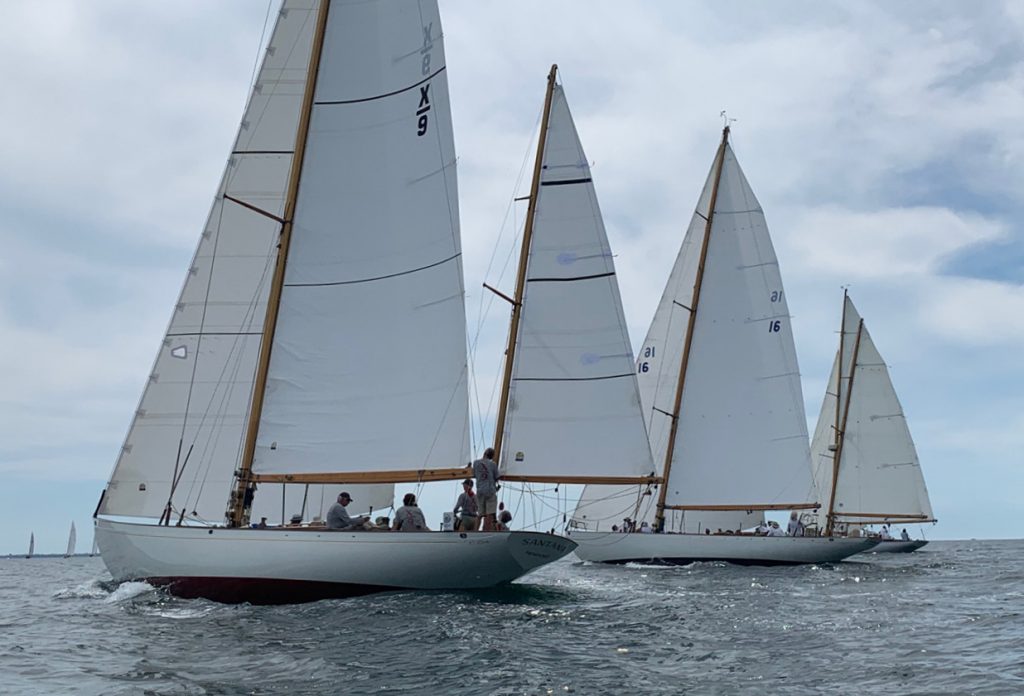Have you ever, in the dead of winter and a long way from sailing, looked back to a stretch in the prior racing season where it seemed you could do no wrong? This was midsummer 2022. The place was Nantucket, Harbor and Sound. The boat was a Nathanael Herreshoff design, the Nantucket Alerion, a boat we profiled in our second Conversations with Classic Boats podcast exactly two years ago.
The story of the modern evolution of this special design places Alerion as the granddaddy of some of Captain Nat’s most popular designs like the Fish Class and the Buzzards Bay 25. Alerion’s little brother, the Herreshoff 12 1/2, numbers over 400 boats built and in turn has spawned the fiberglass Bullseye and Doughdish.

Alerion A-26 wing and wing to the first mark of the 50th Opera House Cup
If you arrive by ferry to the Island of Nantucket, thirty-two miles out to sea, you can’t help but notice a fleet of mid-20s length traditional knockabouts. Entering the Harbor, you round Brant Point, the 19th century harbor light, and there they are with a gorgeous Herreshoff sheer, some painted, some clear finished, a collection of iconic New England boat design.
These are the Nantucket Alerions, 19th century classics brought up to date. Their story spans more than 100 years of tinkering with a design, deemed excellent since the original Alerion III, the personal daysailer of Herreshoff himself, hit the water in Bristol, RI. With short but graceful overhangs, high bow and low stern with a beautiful sheer line connecting them, Alerion is in author Maynard Bray’s words, “one of Herreshoff’s most exquisite creations.”
Nantucket has the largest fleet (thirty-two boats) of these 26-foot classics. Alerion design builders in New England have produced traditional wood designs and modernized modified fiberglass designs in the hundreds. The newest builder, Alerion Yachts in Warren, RI, is the latest to make news with its fiberglass interpretation.
The original Alerion III is enshrined at Mystic Seaport Museum’s small boat shed in her trademark Seafoam Green paint job, Captain Nat’s trademark color. She was born in Bristol from a succession of daysailing designs done during the Golden Age of the Herreshoff Manufacturing Company’s relentless design and building campaigns for massive America’s Cup yachts. Alerion is a mythical bird; the mainsail symbol is a cross between an osprey and a gull, to my eye. Its sturdy combination of sea kindly hull and shoal draft delights racing and gunkholing owners.
Alerion’s modern history dates back to 1979 when the first production boat, built cold-molded and aptly called Serendipity, took to Nantucket Harbor. The Alerion is built to navigate the chop, strong currents and shifting sandbars of a ten-square mile Nantucket Harbor. For cocktail cruiser or fleet racer, she is the quintessential New England knockabout.
The boat itself has eclipsed the local Beetle Cats, called Rainbows, as the subject of tourist photography on the ferries rolling in and out of Nantucket Harbor. Summer 2022 was the time of Revenge Tourism. The local selectman quoted local tourists, non-natives, as up 69 percent year to date as of midsummer. That’s a lot of Instagramming.
Looking back to the prior summer, our Alerion, A-26, built 2006, had been a magnet for disaster. In July 2021, at anchor in the middle of the night, she was run over by a wayward ferry spooked off course by an unlit powerboat darting over its bows in thick fog.
The result was a 26-foot vintage knockabout with a stump of its poor laminated spruce mast resembling the carnage in the aftermath of a Patrick O’Brian sea battle. My owner/skipper was in disbelief, sidelined in the heart of the season. Was there another mast from another boat? No. All that remained was the original 2006 stick lying on its side in the boatyard, bent to the left. We had no choice but to make do. But it was ugly.
We sailed Nantucket Race Week pointing 5 degrees lower than our competitors. The day of the Opera House Cup, the last event of Race Week, was cool and grey with spitting rain. The weather cut the fleet from fifty-five to just over a dozen. We had already seen Tropical Storm Henri wash out Race Week’s small boat events.
Starting with our single reefed main, we were comfortable. We were second to the first mark at Great Point, then proceeded to follow the leader 35 degrees off course to miss the second mark entirely and head for Hyannis. After unwinding our navigational mess, we powered in on a broad reach. What we didn’t know was that we were called OCS at the start…an unforced error for the ages. The result was a humbling non-podium finish for the week, in fact DFL in the Opera House.
Redemption 2022
From an early season combination of cranked up rigging, tight halyards and loose trimming, we finally recovered our windward mojo. We were determined to get back to the podium.

Mark Mayhem: At the 180-degree turn for the finishing leg, A-26 tacks inside Santana (X-9) with Ron Zarella’s A-27 Sea Horse just astern.

Bound for Glory: Having tacked to port, A-26 escapes.
Nantucket Race Week for the Alerion Class is a blend of sprint and distance racing. Two Saturdays of harbor sailing bookend Tuesday’s navigation of the entire Nantucket Harbor, from mid-harbor into the reaches of the Head of the Harbor, a ¾-mile diameter oval of navigable water, tricky shifts and most recently an oyster farm smack in the middle. We had twenty boats, virtually the entire fleet, register and the bulk of them compete.
The first Saturday of around the buoys competition featured a patchy 8-10 knot easterly. We were encouraged with our newly concocted boat speed. Our skipper credited tighter halyards and modified traveler settings. A 4-3-2 string of inishes left us second for the day and the regatta behind the perennial light air specialists of the fleet.
Flash forward to the Harbor Race, three days later. Weekday races on a vacation island create a big problem. If it’s sunny, your crew is either working remotely or sitting on the beach, or both. We drafted one of our 2019 Dolphin crew, a recent MIT B-school grad. We faced an uncertain forecast with winds forecast 10-20 knots northeast. This called for a windward leg past and over the harbor shoals and a chicane turn southeast and northwest into the upper harbor.
A local windsurfing ace put the new owner of the lead boat into play with a shot out of the left side as we were trapped in fourth stalking the leaders. As the fleet reversed through the chicane into a harbor with water levels dropping rapidly with the tide, we waited. Shoal water would be our friend in the second half of the 14-mile course. Two of the three leaders ahead planted themselves on a shoal we all try to avoid. Patience moved us to third and we gave a sigh of relief at the finish.
Now for the second Saturday of our quest for the best. We had three races to move up in the standings. There was a faint southwesterly coming from town, not much movement on the towering wind vane over the high school two miles upwind. We had a plan: Start left, go left. It kept working. In the third race, finally, we were too casual and had to push ourselves back to third before to edging the leader by a boat length in the final race. The term is “Picket Fence” – 1-1-1, not a common score in a competitive fleet. With the throw out, we had a double-digit lead on the second place boat. We won the Alerion Class for Nantucket Race Week 2022.
Huzzah!
Opera House Sunday
This iconic race, the oldest of the Classic Yacht Owners Association series, the Opera House Cup Regatta is a pursuit race on a triangle in Nantucket Sound. The OHC has three features that drive sailors mad. First, you do not know the course until just before the race. You go out to your boat armed with laminated course charts and grease pencils to begin the guessing games: course A or D? Clockwise or counterclockwise? The Oracle of Delphi would be no help here. One improvement for the 2022 Sailing Instructions is the 9 am announcement of the course, giving competitors an extra hour to prepare strategies.
The second feature of the OHC that no one ever seems to master is the starting procedure. It is a unique sequence of signals, too complex to summarize here but including guns at the four minutes to go mark.

Two Olin Stephens classics, Santana (X-9) and Dorade (#16) dueling to the finish.
Now add that pursuit start format; the idea of big fish chasing little fish, which is at the heart of pursuit racing, started with OHC # 49. The premise made sense. During COVID, the RC did not have the personnel to man its support boats. With pursuit, they announced the starting times and sat back to see who crossed first. The first was in 2021 with a dozen boats, half of which were one-design Alerions like ours.
You get your sendoff from the Race Committee by radio. The big guys go last. (The best elapsed time was posted by a modern Spirit of Tradition rocket named Outlier, a 55-foot custom made classic; really a TP 52 design from the Spanish designer Botin.) But Alerions can win in heavy wind. Absent any serious windward work, they are 26-foot reaching and running fiends. In lighter air, they will be steamrollered by the big rigs.
The cumulative effect of all this complexity on our Alerion start was predictable. The race favorite misjudged the signals and was two minutes late. There was a crush at the pin. There was a lot of yelling. We snuck up the stern of the RC boat on port and pirouetted to starboard, off toward what we thought was favorable current and better breeze.
An hour or so later, we arrived at the first mark in mid-Nantucket Sound with a narrow lead. We then headed upwind for what could have been the most pleasant upwind sailing in my Nantucket racing career. Eight knots and smooth water for a delightful hour.
We covered our competitors as they split to their respective corners, we fretted and gave up big chunks of our lead in the middle of the course as we approached the last turning mark of the course, a yellow tetrahedron tucked a mere seventy yards off the western shore of the Nantucket Wildlife Reserve, what we locals know as Great Point.
And what a turn it was with all the makings of a mark rounding pileup, light air, unknown shoals, huge boats converging on the smaller ones. To say we escaped a disaster that in 2021 would have consumed us is the understatement of the sailing summer. Here we had a plan; Sail south to overstand our final starboard tack to the mark and use the north-running current to our advantage. Make a quick 180-degree turn and sprint 3.6 miles to the finish
We held our breath and made that final approach on starboard. In front of us to the east, a phalanx of big boats was lining up on port tack going south, struggling to make way against the tide. Their plan was to clear the mark and turn 90 degrees right to the finishing leg.
We zoomed northeast with the current at our back to face the jutting bowsprit of a port tack biggie, Wendy Schmidt’s 57-foot Santana, looming over us. This is the classic 1935 yawl which was a derivation of the earlier Sparkman & Stephens masterpiece, the 1930-built Dorade. Legend has it that owner Humphrey Bogart regularly invited Frank Sinatra for bacchanals on the boat, docked at Catalina Island off Los Angeles.
It is scary to call “Starboard!” on a 30-ton S & S classic. But we did and Santana tacked away, ever so slowly, to starboard with rival Dorade sailing around them on their leeward side and screaming for water to tack. Santana was dead in her tracks as a NY 32, Siren, cut between them and the mark. This situation was on the verge of mark rounding mayhem.
This was our moment. We got to the mark on starboard and tacked to port intact, then bore off for the finish. We never looked back. We went on to finish almost four minutes ahead of the second boat and sailed in for the party.
At the end of it all, it was a dream season. The owner carted away a bar counter’s haul of trophies. But more importantly, we collected a crewful of memories, choices and hunches, which are the essence of sailboat racing.
What will 2023 bring? We can only hope. A couple of new additions to the Alerion fleet. In 2023, the 51st running of the OHC will be held on the third Sunday of August and we will be there to defend. In the meantime, the summer trophies sit on the bar of our A-26 skipper. Every picture tells a story. ■
Tom Darling is the host of Conversations with Classic Boats, “the podcast that talks to boats.” Tune in via Apple Podcast, Google Podcast or Spotify, or online at conversationswithclassicboats.com.

Scan here to tune into the author’s Conversations with Classic Boats podcast.



